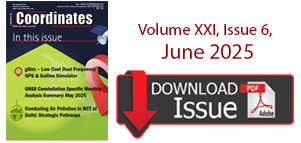| Mapping | |
3D mapping from space?
|
Prof Dr Armin Gruen, Dr Kirsten Wolff
|
||||
|
Lately we observe an amazing increase in earth-observation platforms equipped with ultra high-resolution imagers. With the recent deployment of WorldView-1 we have reached the 0.5 m footprint level. Topo-mapping is worldwide controlled by specifications, which may differ from country to country. Therefore it is difficult to give general recommendations with respect to the question which sensor would be feasible for which map scale. In addition, digital mapping is largely scale-free, which makes the issue even more controversial. In the literature we find many predictions and recommendations on 3D mapping from space, but mostly without substantial empirical evidence. 3D mapping is very often reduced either to the generation of ortho-images or/and to the georeferencing accuracy and DTM generation accuracy. But mapping is much more, as we all know. 3D mapping from satellite imagery is still a topic which causes many misconceptions. We hope we can contribute with this paper to a clarification of some of the issues. What is 3D mapping?A consistent definition of 3D mapping is missing. We are well used to conventional 2D and 2.5D mapping, resulting in an analogue map as final product. 3D mapping however gives us many more options, but also raises more questions. With such new technology of digital mapping we have to address a number of problems, which are not necessarily all new, but so far only sparsely treated in R&D. Among those are: 3D mapping requires totally new approaches to modelling. Most of the |
||||












 (1 votes, average: 1.00 out of 5)
(1 votes, average: 1.00 out of 5)




